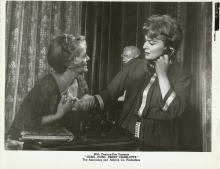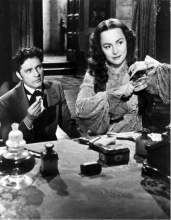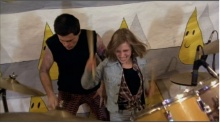This essay on Catch My Soul (aka Santa Fe Satan) was written by Amanda McQueen, faculty assistant in UW Madison’s Department of Communication Arts. A restored DCP of Catch My Soul will screen as the last of our Marquee Monday selections for 2016 on Monday, November 7 at 7 p.m. in the Marquee Theater at Union South. Marquee Monday screenings are co-presented by the Cinematheque and WUD Film.
By Amanda McQueen
For decades, Catch My Soul was considered a lost film. By 1979, just five years after its debut, all available prints seemed to have disappeared. Without the home video release that allowed similarly niche films to find new audiences, Catch My Soul slipped into obscurity, becoming merely an intriguing cinematic footnote. However, thanks to its recent restoration, this low-budget, rock musical version of Shakespeare's Othello now has the chance to develop the cult following many critics feel it deserves.
Catch My Soul was the brainchild of English music and television producer Jack Good, and was originally written for the stage. The musical premiered in 1968 in Los Angeles, with rock legend Jerry Lee Lewis playing the villainous Iago. Following a successful six-week run in LA, Good retooled the show and took it to London, where it was a long-running critical smash. Then, in 1971, Good decided to adapt his musical to the screen and optioned the rights to Metromedia, a television conglomerate diversifying into feature film production. Metromedia's new head of production, Charles W. Fries, set the budget at a modest $750,000.
Good made significant changes to his musical during the adaptation process. Inspired by the landscape surrounding his New Mexico home, he changed Othello from a solider in the army to a preacher in a hippie commune, where Iago, now literally Satan, seeks to bring about his damnation. In addition, much of the original score was replaced with new songs by Tony Joe White ("Polk Salad Annie," "Rainy Night in Georgia").
White also joined the cast of Catch My Soul as Cassio, the pawn in Iago's scheming. He appears alongside rock singer Richie Havens, making his acting debut as Othello, and Lance LeGault, reprising the role of Iago, which he'd played to great acclaim on stage in London. (Perhaps best known for playing Colonel Roderick Decker on The A-Team [1983-1987], LeGault started in Hollywood as Elvis Presley's stunt double.) The cast was rounded out by relative newcomer Season Hubley as Desdemona, Othello's angelic wife, and Susan Tyrrell as Emilia, Iago's wife and partner in crime.
Although he'd directed both stage versions himself, Good opted not to direct the film and asked—some say coerced—actor Patrick McGoohan (The Prisoner [1967-1968], Braveheart [1995]) to take the job. Principal cinematography began in October 1972 with a 28-day shoot around Sante Fe. Accounts from the cast and crew paint a picture of a tense and wild set, plagued by McGoohan's difficult personality, inclement weather, and overly realistic party scenes. By March 1973, McGoohan and editor Richard A. Harris (who later worked with James Cameron on blockbusters like Terminator 2 [1991] and Titanic [1997]) had completed the final cut. Then, reportedly, Jack Good, motivated by his conversion to Catholicism, shot another 15-20 minutes of footage and re-edited the film. McGoohan asked that his name be removed, but the request was ignored.
Catch My Soul premiered in April 1973 at the 3rd Annual USA Film Festival in Dallas, Texas, where it was a favorite among the "younger set." This is certainly what Metromedia and distributor Cinerama were hoping for. The youth-oriented rock musical, with its counter-culture slant and "Jesus Freak"-style of Christianity, was firmly in the mold of Godspell (1973) and Jesus Christ, Superstar (1973). Variety further noted that the film's racial subject matter aligned it with the popular Blaxploitation cycle. In short, Catch My Soul seemed perfectly in tune with the cultural zeitgeist.
The film's box office returns, however, told a different story. In November 1973, Catch My Soul played in London for about three disappointing weeks. When it opened in New York City the following March, its reception was no better. Most critics hated everything but the music; The New York Times advised its readers to "Forget the movie and get the soundtrack album." In October 1974, New Line picked up the distribution rights, retitled the film Sante Fe Satan, and sent it out on the drive-in circuit. The film stayed in circulation a little longer this time around, but played mostly at the bottom of double and triple bills.
And then it was gone. For years, Catch My Soul was known only by its poor reputation and its soundtrack, which continued to attract new fans.
The film's "phantom existence" endured until 2003, when David Spencer, Senior Film Curator at the University of North Carolina School of the Arts, happened upon a 35mm print of Santa Fe Satan that had been discovered in the trailer of 18-wheeler on a farm near Raleigh, NC. While Spencer was investigating options for restoring the film, two additional copies were found: a 16mm print of Catch My Soul at the Folger Shakespeare Library in Washington, D.C., and a 35mm negative in the vaults at 20th Century-Fox, acquired when Fox bought out Metromedia in the late-1990s. Etiquette Pictures, a company dedicated to home video releases of cult and exploitation films, used the Fox negative to complete their restoration of Catch My Soul in 2015. (The title change, unfortunately, was made using the original negative, and so the restoration still announces the film as Santa Fe Satan.)
There's no way of knowing whether an earlier home video release would have allowed Catch My Soul to develop a cult following, and it's hard to imagine this film evolving into a participatory event, like The Rocky Horror Picture Show (1975) or The Room (2003). (If it did, handkerchiefs would definitely be involved.) That being said, Tom Mayer, likely the foremost authority on Catch My Soul, is right when he asserts that this musical has "everything one could ask for in a bizarre, cult obscurity."
Like any true cult film, Catch My Soul is worth at least one viewing. Because, as Craig Butler notes in his review for AllMovie, even if you don’t think it’s a good film, it will at least make you appreciate a time when movies could be “bad in such an interesting way." Shot by Oscar-winning cinematographer Conrad Hall (Cool Hand Luke [1967], Butch Cassidy and the Sundance Kid [1969]), the film looks fantastic, and the songs are toe-tappingly catchy. Though its pace and performances are uneven, its unexpected changes in direction are undeniably engaging. Ultimately, Catch My Soul exemplifies the almost-anything-goes approach of early-1970s Hollywood filmmaking, and as a result, it quite unlike anything else.
For more information on Catch My Soul’s production and restoration, I highly recommend Tom Mayer's four-part article: http://www.theunmutual.co.uk/catchmysoul1.htm










